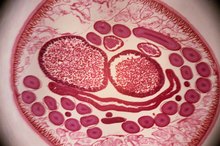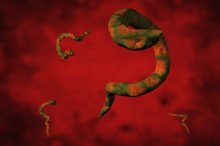The Long-Term Effects of Giardiasis
Infections of the microscopic Giardia parasites, also known as Giardia duodenalis or Giardia lamblia, usually clear up in two to six weeks on their own. However, repeated infections or infections in people with compromised immune systems can have long-term effects, some of them severe. The infections, called Giardiasis, happen in the small intestine when a person drinks or eats contaminated water or food. Giardiasis can also spread by personal contact with another person.
If you are experiencing serious medical symptoms, seek emergency treatment immediately.
Malnutrition and Weight Loss
Many people who have Giardiasis don’t know they are infected. According to the American Medical Association, about two-thirds of infected people have no symptoms. Those with symptoms develop them after about seven days. Symptoms include:
- upset stomach
- nausea
- diarrhea
- gas
- abdominal cramps
- foul-smelling
- greasy stools that have a tendency to float in the toilet bowl
The infection makes it hard for the body to absorb nutrients. This can lead to weight loss. Repeated infections are most likely to occur in people who live in developing countries or in backcountry areas with no water treatment. The repeated insults on a person’s digestive system and long-term malabsorption can cause malnutrition, especially in children.
- Many people who have Giardiasis don’t know they are infected.
- Repeated infections are most likely to occur in people who live in developing countries or in backcountry areas with no water treatment.
Stunted Growth
Symptoms of Roundworms in People
Learn More
The malnutrition caused by Giardiasis can eventually lead to stunted growth in children. This is a condition where a child’s growth is slowed because the body doesn’t have the nutrients it needs. In an article in the "Children and Poverty Journal," authors Eugene Lewit and Nancy Kerrebrock explain that children who fall below the fifth percentile of the reference population in height for age are defined as stunted. Usually, once the cause of the Giardiasis is removed and the infection is treated with antibiotics, the child’s growth rate should catch up. If the Giardia source is not removed, the growth problem will continue and the child may never regain the lost height. Growth stunting can also delay puberty, negatively affect cognitive development and cause premature death.
- The malnutrition caused by Giardiasis can eventually lead to stunted growth in children.
- If the Giardia source is not removed, the growth problem will continue and the child may never regain the lost height.
Lactose Intolerance
According to the New Zealand Ministry of Health, about 40 percent of people with Giardiasis go on to develop lactose intolerance 2. Lactose intolerance is the inability to digest lactose, a sugar found in milk. The sugar is normally digested by an enzyme found in the small intestine. When this enzyme is missing, the lactose accumulates in the intestine and ferments. This can cause symptoms similar to Giardiasis: abdominal cramps, flatulence and diarrhea. For some reason, Giardiasis damages the body’s ability to produce the enzyme that digests lactose.
- According to the New Zealand Ministry of Health, about 40 percent of people with Giardiasis go on to develop lactose intolerance 2.
- Lactose intolerance is the inability to digest lactose, a sugar found in milk.
Related Articles
References
- Centers for Disease Control: Giardiasis
- New Zealand Ministry of Health: Giardia intestinalis
- Haque R. Human intestinal parasites. J Health Popul Nutr. 2007;25(4):387–391.
- Division of Global Migration and Quarantine, National Center for Emerging and Zoonotic Infectious Disease, CDC, USA. Surveillance for travel-related disease — GeoSentinel Surveillance System, United States, 1997–2011. Morbidity and Mortality Weekly Report (MMWR). Published July 2013.
- McClung RP, Roth DM, Vigar M, et al. Waterborne disease outbreaks associated with environmental and undetermined exposures to water — United States, 2013–2014. MMWR Morb Mortal Wkly Rep. 66(44):1222-1225. doi:10.15585/mmwr.mm6644a4
- Centers for Disease Control and Prevention. Illness & Symptoms | Giardia | Parasites | CDC. Updated July 1, 2015.
- Hanevik K, Dizdar V, Langeland N, Hausken T. Development of functional gastrointestinal disorders after Giardia lamblia infection. BMC Gastroenterol. 2009;9(1). doi:10.1186/1471-230X-9-27
- Halliez MC, Buret AG. Extra-intestinal and long term consequences of Giardia duodenalis infections. World J Gastroenterol. 2013;19(47):8974–8985. doi:10.3748/wjg.v19.i47.8974
- Robertson LJ, Hanevik K, Escobedo AA, Mørch K, Langeland N. Giardiasis – why do the symptoms sometimes never stop? Trends in Parasitology. 2010;26(2):75-82. doi:10.1016/j.pt.2009.11.010
- Centers for Disease Control and Prevention (CDC). Pathogen & Environment | Giardia | Parasites. Updated February 2017.
- CDC. Giardiasis surveillance – United States, 2006-2008. MMWR Morb Mortal Wkly Rep. 2010;59(SS06):15-25.
- Centers for Disease Control and Prevention. Giardia & Pets | Giardia | Parasites | CDC. Updated July 21, 2015.
- The University of Michigan. Antigen Tests For Giardiasis | Michigan Medicine. Updated July 30, 2018.
- Hooshyar H, Rostamkhani P, Arbabi M, Delavari M. Giardia lamblia infection: review of current diagnostic strategies. Gastroenterol Hepatol Bed Bench. 2019;12(1):3–12.
- Center for Disease Control and Prevention. General Information | Giardia | Parasites | CDC. Updated July 1, 2015.
- Ryan ET. Hunter’s Tropical Medicine and Emerging Infectious Diseases E-Book. 10th ed. Elsevier Health Sciences; 2019:705-711.doi:10.1016/C2009-0-51934-4
- Centers for Disease Control and Prevention. Treatment | Giardia | Parasites | CDC. Published July 1, 2015.
- Hess, MD E, McMillion, MD B, Niere, MD J. What is the best treatment for Giardia? Evidence-Based Practice:. 2017;20(6):10. doi:10.1097/01.EBP.0000541735.14090.2b
- Granados CE, Reveiz L, Cuervo LG, Uribe LG, Criollo CP. Drugs for treating giardiasis. Granados CE, ed. Cochrane Database of Systematic Reviews. Version published: 2012. doi:10.1002/14651858.cd007787
- Weir CB, Le JK. Metronidazole.StatPearls - NCBI Bookshelf. Treasure Island (FL): StatPearls Publishing; 2019 Jan-. Updated May 17, 2019.
Writer Bio
Marie Zhuikov is an award-winning public relations professional who has been covering medical, environmental, fitness and travel topics since 1984. Zhuikov has a Master of Arts in health journalism from the University of Minnesota, and has produced a variety of products for the Mayo Clinic, Superior National Forest, and the Sea Grant Program.









